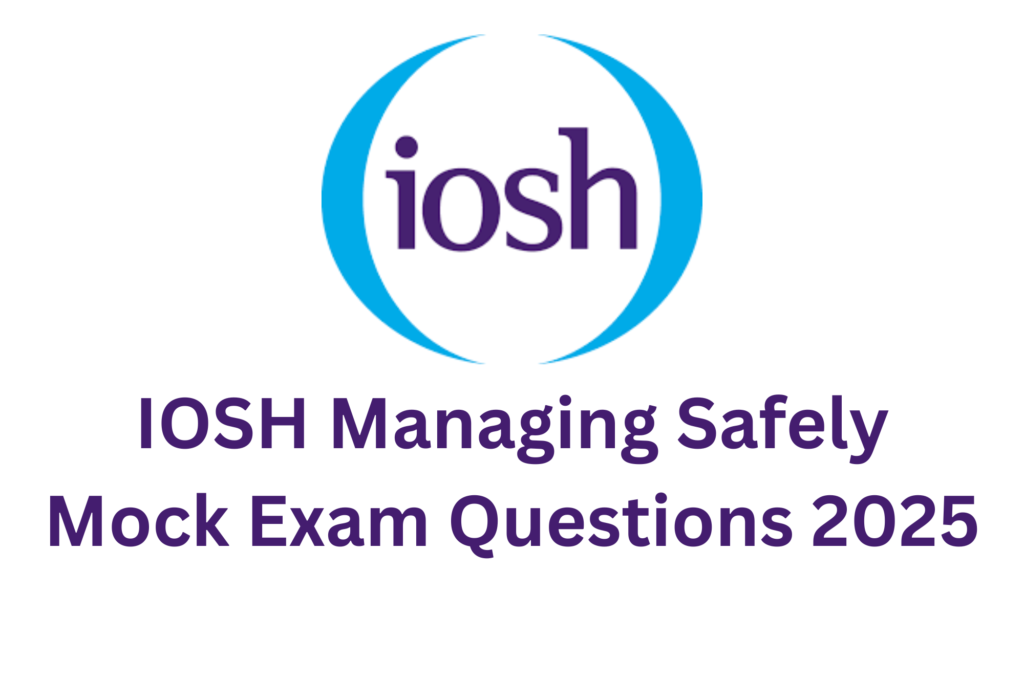IOSH Managing Safely Mock Exam Questions and Answers 2025
The IOSH Managing Safely course is designed to provide managers and supervisors with the knowledge and skills required to manage health and safety in the workplace effectively. Below are some mock exam questions to help you prepare for the IOSH Managing Safely assessment.

Part A: Multiple Choice Questions
- What is the primary purpose of risk assessment?
a) To eliminate all workplace hazards
b) To identify and control hazards
c) To create more paperwork
d) To increase the workload of employees
Answer: b) To identify and control hazards - Which of the following is an example of a workplace hazard?
a) A well-maintained electrical panel
b) A slippery floor
c) An employee wearing PPE
d) A clean and organized workspace
Answer: b) A slippery floor - What does the acronym ‘ALARP’ stand for?
a) As Low As Reasonably Practical
b) Always Look Around for Risk Prevention
c) Avoid Legal Actions and Reduce Penalties
d) Assess Likelihood and Risk Prevention
Answer: a) As Low As Reasonably Practical - Who is responsible for ensuring health and safety in the workplace?
a) The employer only
b) The health and safety officer
c) The government
d) Everyone in the workplace
Answer: d) Everyone in the workplace - Which of the following is an example of a proactive safety measure?
a) Investigating an accident after it occurs
b) Conducting regular safety audits
c) Ignoring minor safety violations
d) Reacting to employee complaints only
Answer: b) Conducting regular safety audits
Part B: Short Answer Questions
- Define the term ‘hazard’ and give an example.
Answer: A hazard is anything that has the potential to cause harm. Example: A frayed electrical wire. - What are the five steps of risk assessment?
Answer:- Identify hazards
- Assess who may be harmed and how
- Evaluate the risks and decide on control measures
- Record findings and implement controls
- Review and update as necessary
- What are the key components of the ‘hierarchy of controls’?
Answer:- Elimination
- Substitution
- Engineering controls
- Administrative controls
- Personal Protective Equipment (PPE)
- Describe the purpose of an accident investigation.
Answer: The purpose of an accident investigation is to determine the root cause of an incident, prevent recurrence, and improve workplace safety. - Explain the difference between a ‘near miss’ and an ‘accident’.
Answer: A near miss is an incident that had the potential to cause harm but did not result in injury or damage, whereas an accident is an event that does result in harm or damage.
Part C: Scenario-Based Questions
- You notice that an employee is not wearing the required PPE while handling hazardous chemicals. What steps would you take to address this situation?
Answer:- Remind the employee of the PPE requirement and its importance.
- Provide training if necessary.
- Ensure PPE is available and in good condition.
- Monitor compliance and enforce safety rules.
- A fire alarm goes off in your workplace. What should be your immediate response? Answer:
- Evacuate the building following the fire safety plan.
- Ensure all employees follow designated escape routes.
- Call emergency services.
- Conduct a headcount at the assembly point.
- Report the incident for review and improvements in fire safety procedures.
FAQs
The IOSH Managing Safely course is a health and safety training program designed for managers and supervisors to equip them with the skills needed to manage safety risks in the workplace.
The course typically takes around three to four days to complete, depending on the training provider.
The passing score is usually around 36 out of 60 for the written exam and at least 23 out of 38 for the risk assessment practical assignment.
Yes, the IOSH Managing Safely certificate is recognized globally and is widely accepted by employers in various industries.
Yes, candidates can retake the exam if they do not pass on the first attempt. It is advisable to review course materials thoroughly before attempting a retake.
